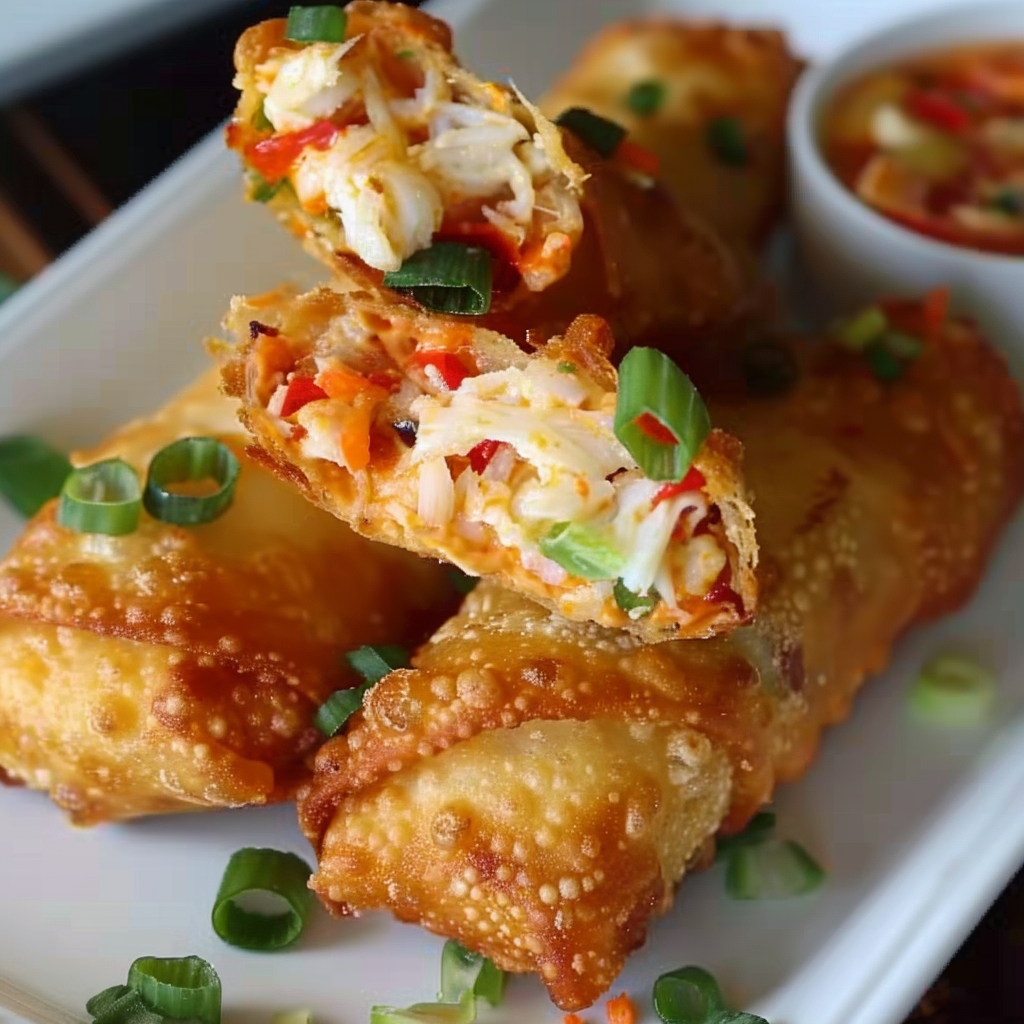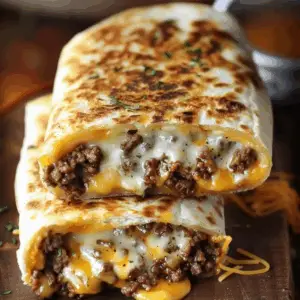1.Why Crab Egg Rolls and Crab Cakes Are the Ultimate Appetizers
Few dishes capture the essence of indulgent, crowd-pleasing appetizers like crab egg rolls and crispy crab cakes. These two seafood staples combine flaky, sweet lump crab meat with bold seasonings and satisfying crunch to deliver a perfect bite every time. Whether you’re planning for a game day spread, a festive gathering, or a cozy dinner at home, these recipes stand out as versatile, flavorful, and surprisingly easy to prepare.
What makes them even more special is their ability to fuse cultural elements into one irresistible dish. Crab egg rolls, for example, marry the familiar structure of Asian-inspired egg rolls with the coastal flavors of Maryland-style crab cakes. The result is a savory fusion that satisfies both traditional and adventurous palates. Learn more about the key ingredient, lump crab meat, and discover why it’s preferred over other types like claw or imitation crab in seafood recipes.
From the buttery interior of a crab cake to the golden crunch of an egg roll wrapper, each element offers texture and depth. This guide will take you step-by-step through everything you need to create these seafood showstoppers at home. With the right ingredients, preparation tips, and creative twists, you’ll master not only how to cook them, but also how to serve them with flair. Check out these seafood party food ideas to elevate your presentation.
By the end, you’ll know how to create the perfect balance of juicy filling and crispy exterior, and understand why crab recipes like these are becoming essential for any modern home cook.
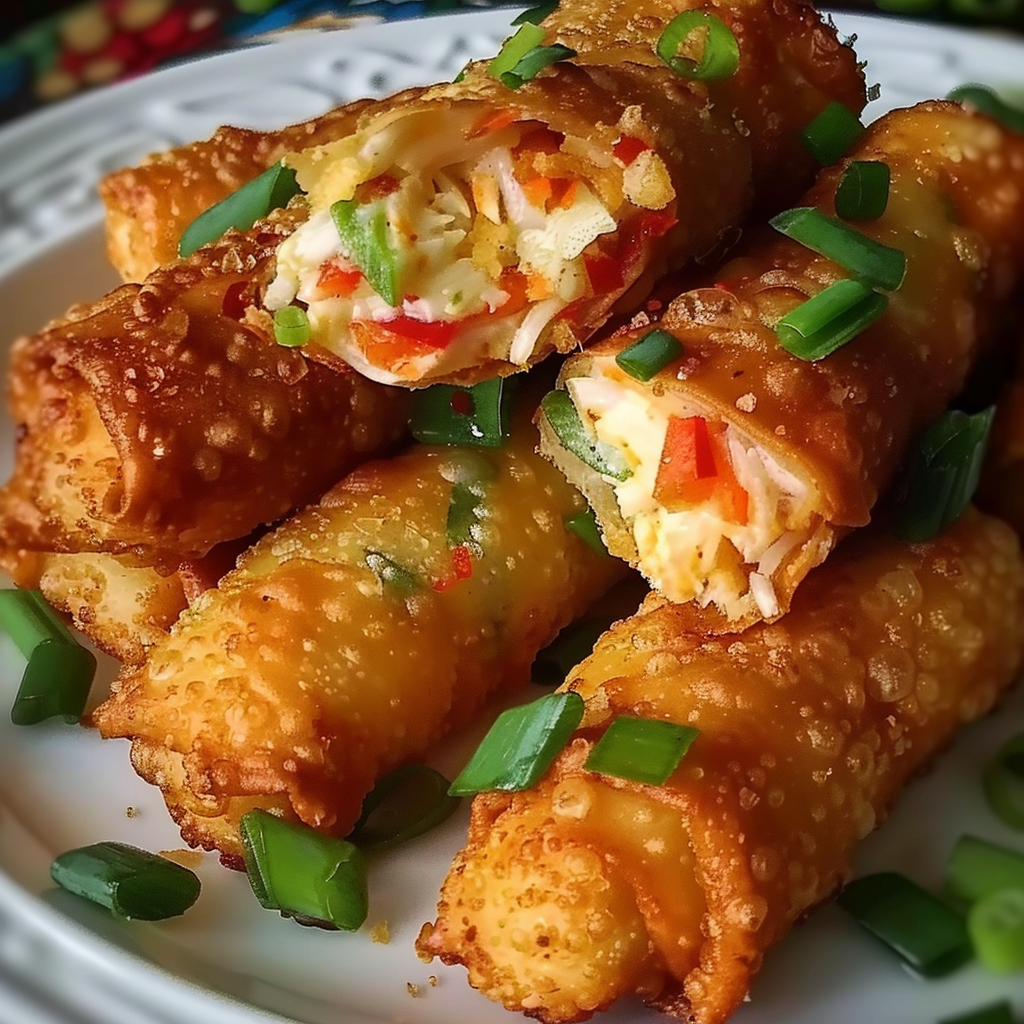
2. What Are Crab Egg Rolls?
Crab egg rolls are a savory fusion dish that blends the iconic flavors of crab cakes with the crispy exterior and convenient shape of traditional egg rolls. At their core, these rolls take a seasoned crab meat mixture—similar to what’s found in a classic crab cake—and wrap it in a thin, pliable egg roll wrapper, which is then deep-fried or air-fried until golden and crunchy.
This fusion of coastal and Asian-American cuisines has gained traction in recent years, becoming a popular alternative to heavier appetizers like fried shrimp or mozzarella sticks. With a lighter texture and a more complex flavor profile, crab egg rolls appeal to seafood lovers and foodies alike. The filling usually includes lump crab meat, breadcrumbs, herbs, spices, and chopped vegetables such as celery and bell pepper. When rolled and fried, the wrapper provides a crispy shell that contrasts perfectly with the tender, moist interior.
Unlike traditional crab cakes, which are typically served on a plate with a fork, crab egg rolls offer handheld convenience. This makes them ideal for parties, casual get-togethers, or even as a creative main course. They’re especially popular as game day appetizers because they’re easy to prepare in large batches and can be dipped into a variety of sauces like spicy mayo or remoulade.
The recipe’s flexibility also allows for endless customization. From adding cream cheese or jalapeños to experimenting with different dipping sauces, home cooks can adapt the core recipe to suit their preferences. What remains consistent, however, is the balance between crunchy texture and the rich, savory flavor of seasoned crab filling.
In essence, crab egg rolls are more than just a novelty—they’re a delicious evolution of two beloved dishes. Whether deep-fried or cooked in an air fryer, they offer the satisfying bite of a crab cake in an easy-to-eat format that’s perfect for any occasion.
3. Ingredients Breakdown: What You Need for Crab Egg Rolls and Crab Cakes
Making flavorful, crispy crab egg rolls and crab cakes starts with selecting the right ingredients. Each component adds texture, moisture, or spice to the overall dish, and knowing their roles helps you achieve the perfect balance between juicy filling and golden crunch.
1. Lump Crab Meat
The foundation of both crab cakes and egg rolls is high-quality lump crab meat. Known for its sweet flavor and flaky texture, this variety holds together well during cooking. Avoid imitation crab if possible, as it lacks the flavor and texture of real crab. Learn more about crab meat varieties to understand why lump crab is the gold standard.
2. Egg Roll Wrappers
A key structural element, egg roll wrappers are thin sheets of dough that crisp up beautifully when fried or air-fried. For best results, use wrappers that are fresh and pliable. These create the signature crunch that makes crab egg rolls so irresistible.
3. Mayonnaise
Acts as a binder and adds moisture to the crab mixture. It also enhances the richness without overpowering the delicate seafood flavor. Mayonnaise is essential for holding the filling together, especially when paired with breadcrumbs.
4. Breadcrumbs
Breadcrumbs help absorb excess moisture and provide structure, especially important in both the crab cake and egg roll forms. Panko or traditional styles work well, depending on the texture you prefer.
5. Seasonings:
-
Old Bay Seasoning: A classic in seafood recipes, Old Bay delivers a signature blend of herbs and spices that complement the sweetness of crab.
-
Dijon Mustard: Adds tang and depth.
-
Worcestershire Sauce: Offers umami complexity—learn more about its origin here.
-
Garlic Powder & Onion Powder: Add base flavor without moisture.
-
Black Pepper: Enhances overall balance without overwhelming the delicate crab.
6. Aromatics and Add-ins:
-
Red Bell Pepper: Adds a mild sweetness and color.
-
Celery: Brings crunch and freshness.
-
Green Onion: Offers a mild, sharp note to brighten the mixture.
-
Parsley: Fresh herbs add earthiness and color.
7. Egg
Beaten egg binds the filling ingredients and helps the mixture hold its shape inside the wrapper.
8. Oil for Frying
Use neutral oils like vegetable or canola for deep frying. They have high smoke points and won’t alter the flavor.
For those looking to lighten up the dish, consider using an air fryer or baking method. These options cut down on oil while still achieving a crispy finish. You can find great visual inspiration for plating and prep in this Pinterest post on crab cake presentation.
Mastering the role of each ingredient ensures your crab egg rolls and crab cakes are perfectly seasoned, structurally sound, and bursting with flavor.
4. How to Make the Crab Cake Mixture (Step-by-Step)
Crafting the perfect crab cake mixture is all about balance—moisture without sogginess, bold flavor without overpowering the natural sweetness of the crab meat. This step is crucial whether you’re making traditional crab cakes or rolling the mixture into crispy egg rolls.
Step 1: Mix the Wet Ingredients First
In a large mixing bowl, combine the mayonnaise, beaten egg, Dijon mustard, Worcestershire sauce, Old Bay seasoning, garlic powder, onion powder, and black pepper. Stir until the mixture is smooth and well-blended. These ingredients form the base of the flavor and provide the moisture that holds everything together. Using high-quality mayonnaise and Worcestershire sauce ensures your base is rich and flavorful.
Step 2: Gently Fold in the Crab and Veggies
Add the lump crab meat to the bowl, along with breadcrumbs, chopped parsley, diced red bell pepper, celery, and green onions. Gently fold the mixture with a spatula or your hands. Be careful not to break apart the crab too much—preserving its texture is key to a juicy bite. For ideas on how to elevate presentation, browse crab cake serving inspiration.
Step 3: Adjust Consistency
The ideal consistency should be moist and sticky, but not wet. If the mixture feels too loose, add a tablespoon more breadcrumbs at a time until it firms up slightly. On the other hand, if it feels too dry, a small spoonful of mayo can help bring it back to balance. This flexibility makes it easy to adjust based on humidity or the moisture content of your crab.
Step 4: Chill the Mixture
Cover the bowl and refrigerate the mixture for at least 20–30 minutes. This helps the flavors meld and makes the filling easier to handle when forming crab cakes or assembling egg rolls. Chilling also reduces the risk of the mixture falling apart during cooking.
Tips for Success:
-
Don’t overmix; it can break down the crab and make the texture mushy.
-
Taste the mixture before adding the egg if you want to adjust seasoning.
-
Avoid using too much salt—Old Bay seasoning already includes sodium.
Once your crab mixture is ready, you’re just a few steps away from transforming it into golden crab cake egg rolls. Whether you pan-fry it into cakes or roll it up in egg roll wrappers, this flavorful base will deliver on both taste and texture.
5. Assembling Crab Cake Egg Rolls Like a Pro
Once your crab cake mixture is perfectly seasoned and chilled, it’s time to assemble your crab egg rolls. This step is where precision meets creativity. Rolling properly ensures a tight seal and helps your egg rolls fry evenly, creating that signature crispy crunch on the outside with tender crab filling inside.
Step 1: Set Up Your Rolling Station
Lay out your egg roll wrappers on a clean, dry surface in a diamond shape (with a corner pointing toward you). Keep a small bowl of water nearby for sealing, and make sure the filling is chilled for easy handling.
Step 2: Add the Filling
Spoon about 2 to 3 tablespoons of the crab mixture onto the center of each wrapper. Avoid overfilling—too much mixture can lead to tears or loose rolls. The key is balance: enough filling for a satisfying bite, but not so much that the wrapper can’t seal.
Step 3: Fold and Roll
Follow this simple technique:
-
Fold the bottom corner up over the filling.
-
Fold in both sides toward the center to enclose the mixture.
-
Roll upward tightly toward the top corner.
-
Dab a little water along the top edge to seal it shut.
This method locks in the filling and creates a uniform shape that fries evenly. If you’re prepping in advance, place the assembled rolls on a parchment-lined tray and cover with plastic wrap to prevent drying.
Step 4: Maintain Wrapper Quality
Keep unused wrappers under a slightly damp towel while you work to prevent them from drying out. Dried wrappers are harder to seal and tend to crack during frying or baking.
Tips for Perfect Assembly:
-
Don’t stack the filled rolls—lay them in a single layer to keep them from sticking together.
-
Use light pressure when rolling. Squeezing too hard can push the filling out or break the wrapper.
-
Seal all edges well to avoid oil seepage during frying.
For healthier prep or diet-conscious options, explore air fryer seafood recipes for alternate cooking methods that retain crispness without deep frying.
Assembling crab cake egg rolls may seem meticulous at first, but with a few practice rolls, it becomes second nature. Whether you’re cooking for a casual gathering or planning a seafood party, these elegant, handheld bites are guaranteed to impress.
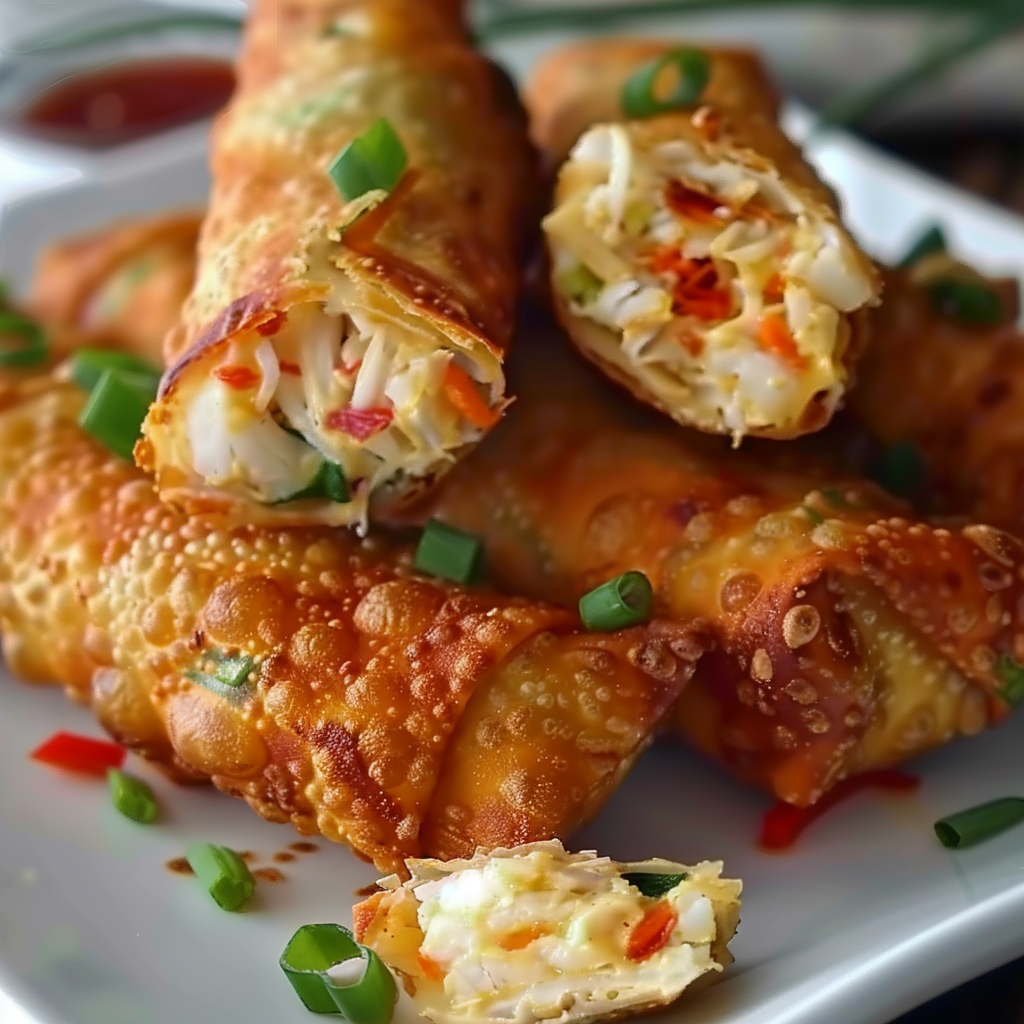
6. Frying Techniques for Perfectly Crispy Rolls
Once your crab cake egg rolls are assembled, the final—and most satisfying—step is frying them to golden perfection. This process locks in the moist, flavorful filling and creates the signature crunchy exterior that makes these rolls irresistible. Mastering oil temperature, timing, and technique is key to achieving the ideal crisp without making the rolls greasy or overcooked.
Choose the Right Oil
Use a neutral, high-smoke-point oil like vegetable oil, canola oil, or peanut oil. These options won’t overpower the flavor of the crab and will withstand high heat without breaking down. Avoid olive oil or butter-based oils, as they can burn and turn bitter at frying temperatures.
Heat the Oil to the Correct Temperature
The ideal frying temperature is 350°F (175°C). Maintaining this temperature is crucial—if the oil is too cool, the wrappers will absorb excess oil and turn soggy; too hot, and the exterior will burn before the inside heats through.
To monitor the temperature:
-
Use a deep-fry thermometer or an electric deep fryer for consistent results.
-
If frying in a skillet, preheat the oil over medium-high heat and test it by dropping in a small piece of egg roll wrapper—it should sizzle immediately.
Frying Method:
-
Carefully lower 2–4 rolls at a time into the hot oil—don’t overcrowd the pan, as this drops the temperature and leads to uneven cooking.
-
Fry each roll for about 3–4 minutes per side, turning as needed to ensure even browning.
-
When the rolls are golden and crispy, remove them with a slotted spoon and place on a paper towel-lined plate to drain excess oil.
For visually stunning results, explore presentation ideas to plate your crab egg rolls alongside sauces and garnishes.
Air Fryer Alternative
If you prefer a lighter option, air frying is an excellent method. Preheat your air fryer to 375°F (190°C), spray the rolls lightly with oil, and cook them in a single layer for 8–10 minutes, turning once halfway through. This technique offers the crunch of deep frying with less oil and mess—perfect for air fryer seafood recipes.
Pro Tips:
-
Always fry in small batches to maintain oil temperature.
-
Let the oil return to 350°F between batches.
-
Drain thoroughly to avoid sogginess.
Perfecting the fry ensures your crab cake egg rolls have the signature crunch that contrasts beautifully with their moist, savory filling. Whether deep-fried or air-fried, crispy rolls elevate any seafood spread with bold flavor and texture.
7. Serving Ideas: Dips, Sauces, and Sides
The best way to serve crab cake egg rolls is with a variety of flavorful dipping sauces and complementary sides. The crisp exterior and rich, savory filling pair perfectly with bold, tangy, or creamy accompaniments, transforming your dish into a restaurant-quality experience.
Top Dipping Sauces to Elevate Flavor:
-
Remoulade Sauce – This creamy, tangy sauce is a classic pairing with crab cakes. Made with mayo, mustard, capers, and herbs, it enhances the dish’s seafood profile. Learn more about remoulade sauce and its origins.
-
Spicy Mayo – A mix of mayonnaise and sriracha or hot sauce delivers heat and creaminess with each bite.
-
Sweet Chili Sauce – Offers a balance of sweetness and spice, perfect for those who enjoy an Asian-fusion twist.
-
Tartar Sauce – A traditional favorite with pickles and lemon for added zest.
-
Garlic Aioli – A rich, garlicky dip that complements the crab’s natural sweetness.
Suggested Sides for a Full Spread:
-
Coleslaw – A refreshing crunch that balances the warm, rich egg rolls.
-
Crispy French Fries or Sweet Potato Fries – Offer a satisfying contrast in texture.
-
Pickled Vegetables – Adds acidity and brightness to the plate.
-
Corn Salad – A summery, sweet side that complements the seafood flavor.
Presentation matters too. Use platters or small baskets lined with parchment paper for casual occasions. For more upscale presentations, explore seafood party ideas for plating inspiration.
When paired with the right sauces and sides, your crab egg rolls become more than an appetizer—they’re the star of the table.
8. Baked or Air-Fried Crab Egg Rolls (Healthier Options)
If you’re looking to enjoy crab egg rolls without deep frying, baking and air frying are both excellent alternatives. These methods reduce oil and calories while still delivering a satisfying crunch—perfect for health-conscious eaters or those seeking a lighter option.
Air Frying Instructions:
-
Preheat air fryer to 375°F (190°C)
-
Lightly spray each roll with oil (olive oil spray works well)
-
Place rolls in a single layer in the basket without overcrowding
-
Cook for 8–10 minutes, flipping halfway through
-
Rolls should be golden brown and crispy on all sides
Explore more air fryer seafood recipes for technique ideas and creative twists.
Baking Instructions:
-
Preheat oven to 400°F (204°C)
-
Place egg rolls on a parchment-lined baking sheet
-
Lightly brush with oil or use cooking spray
-
Bake for 15–18 minutes, flipping once, until golden and crisp
Both methods are perfect for meal prepping or serving large groups. They also eliminate the mess and smell of frying oil while retaining the savory flavors and crispy texture that define crab egg rolls.
9. Turning Crab Cake Mix into Classic Crab Cakes
The beauty of this recipe is its flexibility. The same flavorful crab mixture used for egg rolls can easily be turned into delicious crab cakes—no extra prep needed.
Pan-Frying Instructions:
-
Shape the mixture into small patties (about ½ inch thick)
-
Lightly coat with breadcrumbs for extra texture (optional)
-
Heat oil in a skillet over medium heat
-
Cook each crab cake for 3–4 minutes per side until golden brown
-
Drain on paper towels before serving
Baking Instructions:
-
Preheat oven to 375°F (190°C)
-
Place patties on a lightly greased or parchment-lined baking sheet
-
Bake for 15–20 minutes, flipping once halfway
The result is a tender, flavorful crab cake with a crisp exterior and moist interior. Serve with remoulade sauce or your preferred dip.
Use Pinterest for visual ideas—this crab cake presentation board offers plating inspiration to elevate your serving style.
10. Best Occasions to Serve Crab Egg Rolls and Cakes
Crab egg rolls and crab cakes are versatile enough to suit nearly any occasion. Their upscale flavor and easy-to-eat format make them a top choice for:
-
Game Day Parties – A standout appetizer that’s more exciting than typical snacks.
-
Holiday Gatherings – Impress guests with something unique and flavorful.
-
Dinner Parties – Elegant and easy to prep in advance.
-
Summer Cookouts – Serve with chilled sides and fresh lemonade.
-
Weeknight Dinners – Quick to cook, especially with pre-made filling.
These dishes offer a creative alternative to standard seafood fare. For more ideas, check out this game day appetizer board.
11. Variations and Customizations
The base recipe for crab egg rolls is adaptable, allowing you to experiment with flavors and ingredients to suit your taste.
Creative Add-ins:
-
Cream Cheese – Adds richness and a smooth texture, often used in crab rangoon-style rolls.
-
Jalapeños – Bring heat and crunch.
-
Sweet Corn – Introduces a touch of sweetness.
-
Chopped Shrimp or Lobster – For a deluxe seafood twist.
Flavor Variations:
-
Cajun Style – Use Cajun seasoning instead of Old Bay for a Southern flair.
-
Thai-Inspired – Add lime zest, cilantro, and serve with sweet chili sauce.
-
Spicy Sriracha Mix – Mix sriracha into the filling for heat lovers.
Dietary Adaptations:
-
Use gluten-free egg roll wrappers and GF breadcrumbs to make it celiac-friendly.
-
Swap out mayo for Greek yogurt in the filling for a lighter option.
Customization allows you to tailor the recipe for different dietary needs or flavor preferences—ideal for entertaining or experimenting.
12. Storage, Reheating & Make-Ahead Tips
Proper storage and reheating can keep your crab egg rolls just as delicious the next day. These tips make them a perfect prep-ahead option.
Storing Leftover Rolls:
-
Allow to cool completely
-
Store in an airtight container in the fridge for up to 3 days
-
For longer storage, freeze individually on a tray, then transfer to freezer-safe bags
Reheating Instructions:
-
Air Fryer: Reheat at 375°F for 4–5 minutes
-
Oven: Bake at 375°F for 10–12 minutes
-
Avoid microwaving if possible—it softens the wrapper and reduces crispness
Make-Ahead Tips:
-
You can prepare and roll the egg rolls up to a day in advance
-
Store unbaked rolls in the fridge, covered with a damp towel and plastic wrap
-
If freezing, don’t thaw before air frying or baking—just increase cook time slightly
These storage and prep tips help maintain the integrity of your rolls, so they’re always crispy and full of flavor—even when made ahead.
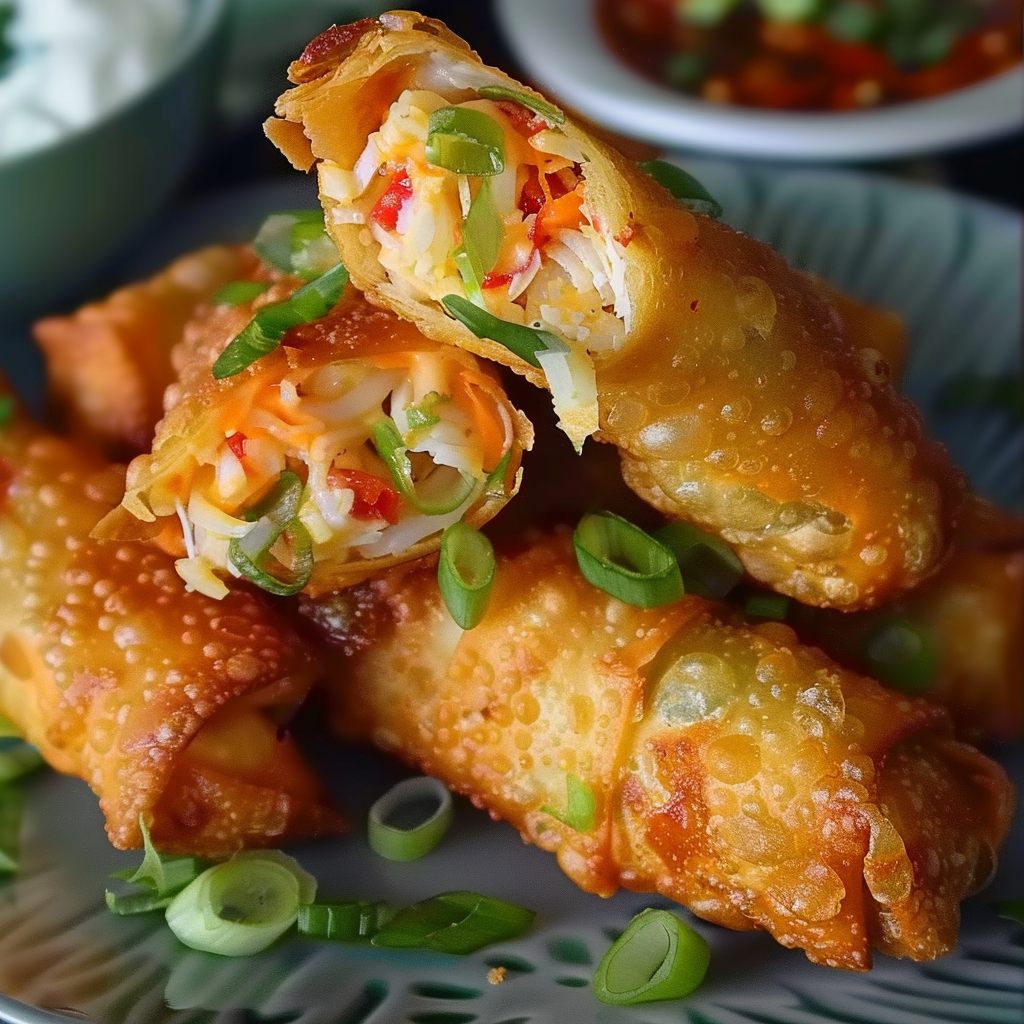
13. Frequently Asked Questions (FAQ)
Can I use canned or imitation crab?
Yes, but it will affect the flavor and texture. Lump crab meat is ideal for the best results. Learn about crab meat types to choose the right one.
What’s the difference between lump crab and claw meat?
Lump crab is sweeter and flakier, while claw meat is darker and more robust. Lump is better for texture in egg rolls.
How do I prevent egg rolls from getting soggy?
Make sure the filling is not too wet, seal the wrapper properly, and fry at the correct temperature. Always drain rolls on paper towels.
Can I bake crab cakes instead of frying them?
Absolutely. Baking is a healthier method and still gives great results. Use the technique described in section 9.
Are crab egg rolls freezer-friendly?
Yes. Freeze them uncooked, then air fry or bake directly from frozen for best texture.
What’s the best dipping sauce for crab cakes?
Remoulade sauce is classic, but spicy mayo and sweet chili sauce also pair well. Check section 7 for full list.
Can I prep these ahead of time for a party?
Yes. Assemble and refrigerate up to a day ahead. Fry or bake right before serving for optimal crispness.
Ultimate Guide to Crab Egg Rolls and Crispy Crab Cakes
These crab cake egg rolls combine the rich, savory flavor of traditional crab cakes with the crispy, satisfying crunch of egg roll wrappers. Packed with lump crab meat, herbs, vegetables, and classic seasonings like Old Bay, they’re the ultimate seafood appetizer. Perfect for game days, holiday parties, or a creative weeknight dinner, this recipe can be pan-fried, air-fried, or baked with equally delicious results. Serve them with remoulade, spicy mayo, or sweet chili sauce for a dish that’s as crowd-pleasing as it is easy to make.
- Author: Clara
Ingredients
For the crab cake mixture:
- 1 lb lump crab meat, picked over for shells
- 1/4 cup mayonnaise
- 1 egg, beaten
- 1 tbsp Dijon mustard
- 1 tsp Worcestershire sauce
- 1 tsp Old Bay seasoning
- 1/2 tsp garlic powder
- 1/2 tsp onion powder
- 1/4 tsp black pepper
- 1/2 cup breadcrumbs
- 2 tbsp chopped parsley
- 1/4 cup finely diced red bell pepper
- 1/4 cup finely diced celery
- 1/4 cup finely diced green onion
For assembling:
- 10–12 egg roll wrappers
- Small bowl of water (for sealing wrappers)
- Vegetable oil, for frying
Instructions
Preheat oil in a deep fryer or large heavy-bottomed skillet to 350°F (175°C).
In a large bowl, combine mayonnaise, beaten egg, Dijon mustard, Worcestershire sauce, Old Bay, garlic powder, onion powder, and black pepper. Mix until smooth.
Add crab meat, breadcrumbs, parsley, red bell pepper, celery, and green onion. Gently fold together until well combined, being careful not to break up the crab too much.
Place an egg roll wrapper on a clean surface in a diamond shape. Add about 2-3 tablespoons of the crab mixture in the center.
Fold the bottom corner over the filling, then fold in the sides and roll tightly. Seal the top edge with a bit of water to close. Repeat with remaining wrappers and filling.
Carefully lower egg rolls into the hot oil and fry for 3-4 minutes per side, or until golden brown and crispy. Do this in batches to avoid overcrowding the pan.
Remove and drain on paper towels.
Serve warm with your choice of dipping sauce (like remoulade or spicy mayo).
Notes
-
Use fresh lump crab for the best flavor and texture—avoid canned or imitation if possible.
-
Chill the crab mixture before rolling to make it easier to handle.
-
Don’t overfill the wrappers to avoid tearing and uneven frying.
-
Use an air fryer for a lighter alternative to deep frying.
-
These egg rolls can be assembled in advance and frozen for up to one month—perfect for make-ahead entertaining.
-
Pair with remoulade or sweet chili sauce for the perfect dipping experience.
